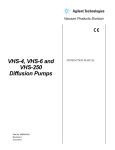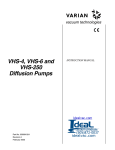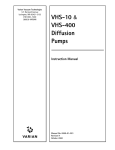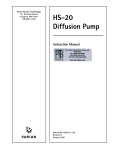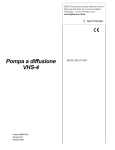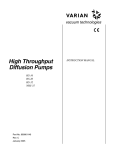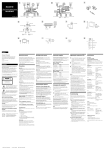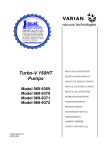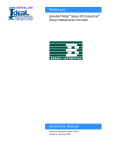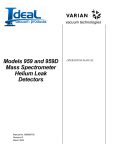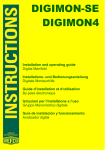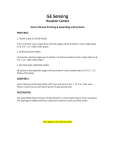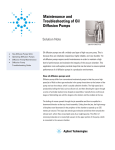Download Varian VHS-6 Instruction manual
Transcript
Varian Vacuum Technologies 121 Hartwell Avenue Lexington, MA 02421-3133 (781) 861-7200 (800) 8-VARIAN VHS-6 Diffusion Pump Instruction Manual Manual No. 6999-01-022 Revision E July 2000 Sales and Service Offices America Varian Vacuum Technologies 121 Hartwell Avenue Lexington, MA 02421, USA Tel: (781) 861 7200 Fax: (781) 860 5437 Toll Free: 1 (800) 882 7426 France Varian s.a. 7 avenue des Tropiques Z.A. de Courtaboeuf – B.P. 12 Les Ulis cedex (Orsay) 91941 France Tel: (33) 1 69 86 38 38 Fax: (33) 1 69 28 23 08 Argentina Varian Argentina Ltd. Sucursal Argentina Av. Ricardo Balbin 2316 1428 Buenos Aires Argentina Tel: (54) 1 783 5306 Fax: (54) 1 786 5172 Germany Varian GmbH Alsfelder Strasse 6 Postfach 11 14 35 64229 Darmstadt Germany Tel: (49) 6151 703 353 Fax: (49) 6151 703 302 Australia Varian Australia Pty., Ltd. 6/81 Frenchs Forest Road Frenchs Forest, NSW 2086 Australia Tel: (61) 2 9975 8805 Fax: (61) 2 9452 2600 Hong Kong Varian Technologies Asia, Ltd. Rm 2611 Concordia Plaza New Mandarin Plaza 1 Science Museum Rd., Tsimshatsui East, Kowloon Hong Kong Tel: (852) 26206173 Fax: (852) 26206338 Brazil Varian Industria e Comercio Ltda. Avenida Dr. Cardoso de Mello 1644 Vila Olimpia Sao Paulo 04548 005 Brazil Tel: (55) 11 820 0444 Fax: (55) 11 820 9350 Canada Varian Canada 6705 Millcreek Drive, Unit 5 Mississauga, Ontario L5N 5R9 Canada Tel: (800) 882 7426 Fax: (781) 860 5437 China Varian China Ltd. Room 1201, Jinyu Mansion No. 129A Xuanwumen Xidajie Xicheng District Beijing 100031 P.R. China Tel: (86) 10 6641 1530 Fax: (86) 10 6641 1534 Varian Shanghai Service Station 716 Yishan Road Shanghai P.R. China 200233 Tel: (86) 21 6483 5576 Fax: (86) 21 6485 9031 England Varian Ltd. 28 Manor Road Walton-On-Thames Surrey KT 12 2QF England Tel: (44) 1932 89 8000 Fax: (44) 1932 22 8769 India Varian India PVT LTD 1010 Compotent House 7, Nangal Raya Business Centre New Delhi 110 046 India Tel: (91) 11 5548444 Fax: (91) 11 5548445 Italy Varian Vacuum Technologies via Flli Varian 54 10040 Leini, (Torino) Italy Tel: (39) 011 997 9111 Fax: (39) 011 997 9350 Japan Varian Vacuum Technologies Sumitomo Shibaura Building, 8th Floor 4-16-36 Shibaura Minato-ku, Tokyo 108 Japan Tel: (81) 3 5232 1253 Fax: (81) 3 5232 1263 Korea Varian Technologies Korea, Ltd Shinsa 2nd Bldg. 2F 966-5 Daechi Dong Kangnam Gu, Seoul Korea 135-280 Tel: (82) 2 3452 2452 Fax: (82) 2 3452 2451 Netherlands Varian Vacuum Technologies Rijksstraatweg 269 H, 3956 CP Leersum The Netherlands Tel: (31) 343 469910 Fax: (31) 343 469961 Mexico Varian S.A. Concepcion Beistegui No 109 Col Del Valle C.P. 03100 Mexico, D.F. Tel: (52) 5 523 9465 Fax: (52) 5 523 9472 Singapore Varian Asia, Ltd. 1123 Serangoon Road #03-02 Singapore 328207 Tel: (65) 296 9688 Fax: (65) 296 9733 Spain Varian Iberica Avda Pedro Diez 25 28019 Madrid Spain Tel: (34) 91 4727612 Fax: (34) 91 4725001 Russia Varian Moscow 19A Khlebny per 121019 Moscow Russia Tel: (70) 95 9374280 Fax: (70) 95 9374281 Taiwan Varian Technologies Asia Ltd., Taiwan Branch 18F-13 No.79, Hsin Tai Wu Road Sec. 1, Hsi Chih Taipei Hsien Taiwan Tel: (886) 2 2698 9555 Fax: (886) 2 2698 9678 Internet Users: Visit us on the web at: www.eVarian.com Representatives in most countries WARRANTY Products manufactured by Seller are warranted against defects in materials and workmanship for twelve (12) months from date of shipment thereof to Customer, and Seller's liability under valid warranty claims is limited, at the option of Seller, to repair, replacement, or refund of an equitable portion of the purchase price of the Product. Items expendable in normal use are not covered by this warranty. All warranty replacement or repair of parts shall be limited to equipment malfunctions which, in the sole opinion of Seller, are due or traceable to defects in original materials or workmanship. All obligations of Seller under this warranty shall cease in the event of abuse, accident, alteration, misuse, or neglect of the equipment. In-warranty repaired or replacement parts are warranted only for the remaining unexpired portion of the original warranty period applicable to the repaired or replaced parts. After expiration of the applicable warranty period, Customer shall be charged at the then current prices for parts, labor, and transportation. Reasonable care must be used to avoid hazards. Seller expressly disclaims responsibility for loss or damage caused by use of its Products other than in accordance with proper operating procedures. When products are used with toxic chemicals, or in an atmosphere that is dangerous to the health of humans, or is environmentally unsafe, it will be the responsibility of the Customer to have the product cleaned by an independent agency skilled and approved in handling and cleaning contaminated materials before the product will be accepted by Varian Associates for repair and/or replacement. Except as stated herein, Seller makes no warranty, express or implied (either in fact or by operation of law), statutory or otherwise; and, except as stated herein, Seller shall have no liability under any warranty, express or implied (either in fact or by operation of law), statutory or otherwise. Statements made by any person, including representatives of Seller, which are inconsistent or in conflict with the terms of this warranty shall not be binding upon Seller unless reduced to writing and approved by an officer of Seller. Warranty Replacement and Adjustment All claims under warranty must be made promptly after occurrence of circumstances giving rise thereto, and must be received within the applicable warranty period by Seller or its authorized representative. Such claims should include the Product serial number, the date of shipment, and a full description of the circumstances giving rise to the claim. Before any Products are returned for repair and/or adjustment, written authorization from Seller or its authorized representative for the return and instructions as to how and where these Products should be returned must be obtained. Any Product returned to Seller for examination shall be prepaid via the means of transportation indicated as acceptable by Seller. Seller reserves the right to reject any warranty claim not promptly reported and any warranty claim on any item that has been altered or has been returned by non-acceptable means of transportation. When any Product is returned for examination and inspection, or for any other reason, Customer shall be responsible for all damage resulting from improper packing or handling, and for loss in transit, notwithstanding any defect or non-conformity in the Product, in all cases, Seller has the sole responsibility for determining the cause and nature of failure, and Seller's determination with regard thereto shall be final. If it is found that Seller's Product has been returned without cause and is still serviceable, Customer will be notified and the Product returned at its expense; in addition, a charge for testing and examination may be made on Products so returned. 8/15/95 OPERATION AND MAINTENANCE OF THIS EQUIPMENT INVOLVES SERIOUS RISK. IT IS THE RESPONSIBILITY OF THE USER TO MAINTAIN SAFE OPERATING CONDITIONS AT ALL TIMES. VARIAN ASSUMES NO LIABILITY FOR PERSONAL INJURY OR DAMAGE RESULTING FROM OPERATION OR SERVICE OF THE EQUIPMENT. Carelessly or improperly operated equipment can cause serious injury or death and/or damage to the equipment. The emergency and safety procedures in this manual are provided to help users and qualified persons to operate and service the unit safely. Recommendations are believed to reflect accepted industry practices in effect on the date of publication of this manual. Special applications must be reviewed and approved by an industrial hygienist or chemical safety engineer. Varian has no control over the use of this equipment and is not responsible for personal injury or damage resulting from its use. The safe use and disposal of hazardous or potentially hazardous materials of any kind is the sole responsibility of the user. Observe all WARNINGS and CAUTIONS to minimize the serious hazards involved. It is the sole responsibility of users of Varian equipment to comply with all local, state, and federal safety requirements (laws and regulations) applicable to their system. Employ the services of an industrial hygienist and/or a qualified chemical safety engineer in order to ensure safe installation and use. This instruction manual contains information which will assist qualified operators in the operation, and qualified service engineers to carry out field-servicing the Varian equipment. i SAFE INCORPORATION OF VARIAN DIFFUSION PUMPS INTO VACUUM SYSTEMS IS THE RESPONSIBILITY OF THE SYSTEMS DESIGNER. TAKE APPROPRIATE ACTION THROUGH REDUNDANCY, AND/OR OTHER SAFEGUARDS TO PROTECT PERSONNEL AND PROPERTY FROM THE HAZARDS DESCRIBED BELOW AND IN THE INSTALLATION, OPERATION, AND MAINTENANCE INSTRUCTION MANUAL. SAFE OPERATION IS THE RESPONSIBILITY OF THE USING ORGANIZATION AND ITS PERSONNEL. READ THE INSTRUCTION MANUAL AND UNDERSTAND HOW TO AVOID HAZARDS PRIOR TO OPERATING THE DIFFUSION PUMP. ALL PERSONS WHO WORK WITH OR ARE EXPOSED TO DIFFUSION PUMPS OR EQUIPMENT WHICH UTILIZES SUCH PUMPS OR DIFFUSION PUMP FLUID MUST TAKE PRECAUTIONS TO PROTECT THEMSELVES AGAINST POSSIBLE SERIOUS BODILY INJURY OR DEATH. DO NOT BE CARELESS AROUND SUCH PRODUCTS. THESE SHEETS AND THE INSTALLATION, OPERATION, AND MAINTENANCE INSTRUCTIONS CAN HELP YOU TO OPERATE THIS PUMP SAFELY AND EFFICIENTLY. READ THEM. SPECIAL OPERATING CONSIDERATIONS AND PRECAUTIONS WILL BE FOUND IN THE OPERATION INSTRUCTIONS. UNINFORMED OR CARELESS OPERATION OF THIS PUMP CAN RESULT IN POOR PERFORMANCE, DAMAGE TO THE PUMP OR OTHER PROPERTY, SERIOUS BODILY INJURY, AND POSSIBLE DEATH. USERS OF THIS EQUIPMENT SHOULD BE ALERT TO TWO LEVELS OF HAZARDS IDENTIFIED BY THE FOLLOWING SYMBOLS: WARNING _____________ Warnings are used when failure to observe instructions or precautions could result in injury or death to humans. CAUTION ________ Cautions are used when failure to observe instructions could result in significant damage to equipment and/or facilities. Designers of systems which utilize diffusion pumps must design out hazards wherever possible; provide guards, safety features, and interlocks for hazards which cannot be designed out; warn with respect to hazards which cannot be designed out and which remain after utilizing guards, safety features, and interlocks; and lastly, provide procedures and instructions on proper use, servicing, etc., so as to minimize risk. ii THE INSTALLATION, OPERATION, AND/OR SERVICING OR DIFFUSION PUMPS INVOLVES ONE OR MORE OF THE FOLLOWING HAZARDS, ANY ONE OF WHICH, IN THE ABSENCE OF SAFE OPERATING PRACTICES AND PRECAUTIONS, COULD POTENTIALLY RESULT IN DEATH OR SERIOUS HARM TO PERSONNEL. Hazard Suggested Corrective Action Loss of utility: water and/or electricity Provide sufficient water and backup power to effect a safe shutdown under worst case conditions. Overpressure in foreline Provide an interlock to ensure that the power supply to the pump heater cannot be activated if the foreline pump is not running AND/OR pressure in foreline is above 0.5 Torr (66.5 Pa). Overtemperature Fit temperature sensors and pump fluid level sensors with feedback to an interlock on the heater power supply. Insufficient water flow through the main cooling coils Use water flow sensor and feedback to interlock on the heater power supply. Water trapped between inlet and outlet of quick-cool coil, or liquid nitrogen trapped between inlet and outlet of liquid nitrogen trap Provide vent or pressure relief valves for both quick-cool coil and liquid nitrogen trap. Loss of ground integrity Incorporate ground fault interrupt circuit into heater power supply. Positive pressure in pumping system Integrate pressure relief valve in vacuum system. High voltage Prevent personnel contact with high voltages; design and attach warnings. Toxicity/Corrosivity Toxic and/or corrosive gases must be vented to a safe location, ensuring adequate dilution or scrubbing to safe levels, taking all action required to meet air quality standards. iii Hazard Explosion Suggested Corrective Action Integrate pressure relief valves in all systems using pumps 10 inches or larger in diameter. Do not use or recommend the use of hydrocarbon-based pumping oils. a. Explosion – Operation of the diffusion pump without prior and continuous evacuation (below 0.5 Torr (66.5 Pa)) or coolant and introducing a strong oxidizer (such as air) or explosive vapors or powders or materials which may react with pumping fluids into a hot (above 300°F or 150°C) pump can cause an explosion. Such an explosion can violently expel valves and other hardware, slam open doors that are not designed for appropriate pressure relief, or burst other components of the vacuum system. Serious injury or death may result from expelled parts, doors, shrapnel, and/or shock waves. b. All diffusion pumps are typically cleaned with acetone or alcohol. When combined with air, oxygen, and other oxidizers, alcohol and most other solvents are very flammable and explosive. Never permit any trace of these cleaners to remain in or on the pump. Always remove all traces of alcohol and acetone and other cleaners with clean, dry, oil-free compressed air. Three elements are required: fuel, oxidizer, and source of ignition. A combination of temperature and pressure can be a source of ignition. Most diffusion pump fluids except mercury are fuels. Hydrocarbon oils are more prone to oxidize and explode than synthetic silicone-based oil. Oxidizers can be air (a strong oxidizer) from a leak or can be deliberately introduced in a process or can be inadvertently admitted to the system by operator or process controller error. Oxygen and other strong oxidizers are even more dangerous. Certain conditions of temperature and pressure can cause a combustible mixture to explode. The larger the diffusion pump, the greater the risk of explosion and the greater the risk of damage and/or injury. Never operate diffusion pumps larger than 10 inches in diameter with hydrocarbon oils without a full safety analysis for the complete system and application. Never operate any diffusion pump in the following ways because they increase the probability of an explosion. Prohibited Action Explosion-Causing Condition Run pump with no cooling water Overtemperature Run pump with low level of pump fluid Overtemperature Run pump without proper backing or holding pump Overpressure Run pump when not evacuated below 0.5 Torr (66.5 Pa) Overpressure Admit air to, or rough through, a pump with hot boiler Overpressure plus strong oxidizer iv Prohibited Action Explosion-Causing Condition Open drain or fill plug while pump is under vacuum, especially when it is hot Overpressure plus strong oxidizer Contaminate pump with explosive vapors, powders, or reactive materials Lower explosive threshold of gas mixtures Remove, defeat, or override safety countermeasures such as pressure and thermal switches and valve sequencer interlocks Overtemperature, overpressure, more combustible mixtures Machine or weld without removing all oil or solvent residue in pump Source of ignition Use unsuitable pumping fluid especially in large pumps Lower explosive threshold of gas mixture Systems larger than 10 inches must be designed with pressure relief devices to provide safe pressure relief from internal explosions. Always recognize that safety devices can fail or malfunction. Provide redundant protection by installing devices having different failure modes, failure mechanisms, and failure causes. Be certain that exhaust duct materials are capable of withstanding the corrosivity, temperature, and pressure of exhausted products. c. Pressure – Pumps and their components are designed for vacuum service; they are not designed to be pressurized which could cause them to burst possibly expelling shrapnel at lethal velocities. Serious accidents have been caused by intentional pressurization of vacuum systems and their components. Never pressurize any part of a vacuum system for test or any other purpose. Always provide pressure relief when designing diffusion pumps into systems and ensure that pressure relief motion is limited to safe envelopes. Never permit the following: Prohibited Action Result Block inlet and vent of liquid nitrogen trap and lines LN2 trap and/or lines burst Close isolation valves at inlet and discharge of main watercooling coils and pump is reheated Water turns to steam and bursts coils Pressurize pump body Body of pump bursts Hole through vacuum wall Loss of structural integrity of wall v d. Poisonous and/or Corrosive Compounds – When pumping poisonous, reactive, and/or corrosive gas, vapors, or chemicals, even proper operation and regeneration will not always ensure that all hazardous materials have been totally removed. If hazardous gas, vapors, chemicals, or combustible mixtures are pumped, sufficient quantities may exist during operation or remain after regeneration to cause severe injury or death. Overheating the pump oil, exposing it to air or reactive materials, or overpressurizing it above the normal operating range (approximately 1mTorr (.133 Pa)) will decompose the oil and possibly make it toxic. This is especially true of backstreamed mechanical pump oils which are more volatile (unstable). Overheating of accidentally introduced or backstreamed mechanical pump oils cannot be protected against by thermal switches which are set for diffusion pump oil. d. Refer to specific instruction manuals for detailed instructions and precautions. Always vent the pump and relief valve to a safe location thus ensuring adequate dilution to safe levels, and take all other action required to meet quality air standards. Always handle pump fluids and hardware with an awareness of the possible deadly hazards involved and the necessity for great care and attention to safety precautions. d. Diffusion pumps are typically cleaned with acetone or alcohol. Acetone, alcohol, and most other solvents are irritants, narcotics, and depressants, and/or carcinogenic. Their inhalation and ingestion may produce serious effects. Even absorption through the skin can result in moderate toxicity. Always ensure that cleaning operations are performed in large, well-ventilated rooms. Use of selfcontained breathing apparatus may be necessary depending upon the solvent type and vapor concentration in surrounding air. e. High Voltage – Diffusion pumps operate at voltages high enough to kill through electrical shock. Design equipment utilizing these pumps to prevent personnel contact with high voltages. Securely attach prominent hazard warnings. Personnel should always break the primary circuit to the power supply when direct access to the heater or wiring is required. f. Hot Surfaces – Boiler temperatures reach 530°F (275°C) which can cause serious burns when touched. Always ensure that surfaces have cooled near room temperature before touching them. g. Hot Coolant and/or Steam – The water used to cool the pump can reach scalding temperatures. Touching or rupture of the cooling surface can cause serious burns. Water left inside quick cool coils from previous use will turn to steam when the pump is reheated. This steam must be allowed to escape without contacting personnel. Whenever possible, design the water system with interlock valves so that power cannot be applied to the pump unless water is flowing in the main cooling coils (not quick-cooling coils). h. Cold Surfaces – Liquid nitrogen traps cooled by liquid nitrogen are commonly used in diffusion pumps. Metal surfaces at liquid nitrogen temperature can cause severe frostbite if contacted by unprotected skin. These surfaces remain cold for some time (at least a half hour) after the liquid nitrogen has evaporated. vi i. Cold Coolant – Liquid nitrogen, a cryogenic liquid, is used in traps. If it is splashed on body tissues or eyes, it can cause severe frostbite or blindness. The extremely low temperature of liquified nitrogen can cause skin damage similar to high temperature burns. Contact with the cold gas evolving from the liquid may produce the same effect. Delicate tissues, such as the eye tissues, are most easily damaged by exposure to cold gas or liquid. To minimize the risk of hazardous contact of cold gaseous nitrogen with any part of the body, wear personal safety equipment recommended for use with cryogenic materials including face shield, full-sleeved lab coat, and clean, dry gloves which fit loosely so they can be thrown off quickly if frozen by contact with the gas. j. Asphyxiation – If a large amount of liquid nitrogen is spilled in a small, poorly ventilated room or equipment, death from suffocation can result. All diffusion pumps are typically cleaned with acetone or alcohol. Acetone, alcohol, and most other solvents are very volatile (unstable). During cleaning, the volatility of these cleaners may permit their gases to displace air and its life-supporting oxygen which could cause death or serious injury by asphyxiation. Always ensure that cleaning operations are performed in large, well-ventilated areas. j. While still hot, the diffusion pump may also contain decomposed and/or overheated pump oils which can also be an asphyxiant. k. Large, Heavy Weights – Diffusion pumps larger than 10 inches in diameter require powerassisted equipment and the use of trained moving/installation personnel in order to avoid dropping, slipping, and/or overturning the pump thus severely injuring personnel. Check weight of equipment before lifting and do not stand under equipment being moved. vii WARNING _____________ High voltages can kill. Always break the primary circuit to the power supply before starting to work on the heater and/or its wiring. WARNING _____________ Diffusion pumps are typically cleaned with acetone, alcohol, or other solvents. When heated, sprayed or exposed to high temperature equipment, these solvents become flammable and explosive, causing serious injury or death. Do not use near a high-temperature source. Ventilate working area with a blower and use in large, well-ventilated room. When heated or sprayed, solvents also becomes 4 to 5 times heavier than air and will flow down, settling in tanks, pits, and low areas, thus displacing air which can kill by asphyxiation. Use in a large, well-ventilated room. Use of a self-contained breathing apparatus may be necessary. Acetone, alcohol, and other solvents are irritants, narcotics, depressants, and/or carcinogenics. Their inhalation and/or ingestion may produce serious effects. Prolonged or continued contact with the skin will result in absorption through the skin and moderate toxicity. Always ensure that cleaning operations are carried out in large, well-ventilated rooms, and wear eyeshields, gloves, and protective clothing. WARNING _____________ Varian has no control over the types of gases passing through this pump. These are entirely under the control of the process user and/or the hardware systems integrator. Frequently, process gases are toxic, flammable, corrosive, explosive, or otherwise reactive. Since these gases can cause serious injury or death, it is very important to plumb the exhaust of the pump to the facility’s hazardous gas exhaust system which incorporates appropriate filters, scrubbers, etc., to insure that the exhaust meets all air and water pollution control regulations. WARNING _____________ Certain gases can become corrosive and toxic when trapped in oil. Always wear protective gloves when handling dirty pump oil, drain it into a closable container, and do not breathe the fumes of the oil. Always use fully self-contained breathing apparatus. viii WARNING _____________ Hot oils can cause serious burns. Wear protective gloves and long sleeved, loose fitting, heat resistant garments when draining pump oil. WARNING _____________ When lifting some Varian diffusion pumps, use power-assisted equipment and trained moving/installation personnel to avoid dropping, slipping, and/or overturning the pump and severely injuring personnel. Check weight of equipment before lifting and do not stand under equipment being moved. CAUTION ________ Alcohol, acetone, and other solvents degrade O-ring materials reducing their ability to hold a vacuum. Do not use acetone or other solvents on O-rings. If necessary to clean O-rings, wipe with lint-free, clean cloth, wash in detergent and water, or use a small amount of pump oil. NOTE ________ Always dispose of used or dirty oil properly and in compliance with all local, state, and federal environmental laws and regulations. ix Table of Contents Section Page Section I – Installation . . . . . . . . . . . . . . . . . . . . . . . . . . . . . . . . . . . . . . . . . . . . . . . . . . . . . . . . 1-1 1-1 1-2 1-2-1 1-2-2 1-2-3 1-2-4 1-2-5 1-2-6 Specifications . . . . . . . . . . . . . . . . . . . . . . . . . . . . . . . . . . . . . . . . . . . . . . . . . . . . . . . . . . Installation . . . . . . . . . . . . . . . . . . . . . . . . . . . . . . . . . . . . . . . . . . . . . . . . . . . . . . . . . . . . . Unpacking . . . . . . . . . . . . . . . . . . . . . . . . . . . . . . . . . . . . . . . . . . . . . . . . . . . . . . . . . . . . . Pump Oil Installation . . . . . . . . . . . . . . . . . . . . . . . . . . . . . . . . . . . . . . . . . . . . . . . . . . . . . Vacuum System Connections . . . . . . . . . . . . . . . . . . . . . . . . . . . . . . . . . . . . . . . . . . . . . . Cooling Water Connections . . . . . . . . . . . . . . . . . . . . . . . . . . . . . . . . . . . . . . . . . . . . . . . . Electrical Connections . . . . . . . . . . . . . . . . . . . . . . . . . . . . . . . . . . . . . . . . . . . . . . . . . . . Thermal Switch . . . . . . . . . . . . . . . . . . . . . . . . . . . . . . . . . . . . . . . . . . . . . . . . . . . . . . . . . 1-1 1-2 1-2 1-2 1-2 1-3 1-3 1-4 Section II – Operation . . . . . . . . . . . . . . . . . . . . . . . . . . . . . . . . . . . . . . . . . . . . . . . . . . . . . . . . 2-1 2-1 2-2 Startup Procedure . . . . . . . . . . . . . . . . . . . . . . . . . . . . . . . . . . . . . . . . . . . . . . . . . . . . . . . Shutdown Procedure . . . . . . . . . . . . . . . . . . . . . . . . . . . . . . . . . . . . . . . . . . . . . . . . . . . . . 2-1 2-2 Section III – Maintenance and Service . . . . . . . . . . . . . . . . . . . . . . . . . . . . . . . . . . . . . . . . . . . 3-1 3-1 3-2 3-3 3-4 3-5 3-6 3-7 General . . . . . . . . . . . . . . . . . . . . . . . . . . . . . . . . . . . . . . . . . . . . . . . . . . . . . . . . . . . . . . . Periodic Inspection . . . . . . . . . . . . . . . . . . . . . . . . . . . . . . . . . . . . . . . . . . . . . . . . . . . . . . Cleaning . . . . . . . . . . . . . . . . . . . . . . . . . . . . . . . . . . . . . . . . . . . . . . . . . . . . . . . . . . . . . . Cold Cap Removal/Installation . . . . . . . . . . . . . . . . . . . . . . . . . . . . . . . . . . . . . . . . . . . . . Jet Assembly Removal/Installation . . . . . . . . . . . . . . . . . . . . . . . . . . . . . . . . . . . . . . . . . . Heater Replacement . . . . . . . . . . . . . . . . . . . . . . . . . . . . . . . . . . . . . . . . . . . . . . . . . . . . . Adding Pump Fluid . . . . . . . . . . . . . . . . . . . . . . . . . . . . . . . . . . . . . . . . . . . . . . . . . . . . . . 3-1 3-1 3-1 3-2 3-3 3-4 3-4 Section IV – Troubleshooting . . . . . . . . . . . . . . . . . . . . . . . . . . . . . . . . . . . . . . . . . . . . . . . . . . 4-1 4-1 4-2 4-3 Leakage . . . . . . . . . . . . . . . . . . . . . . . . . . . . . . . . . . . . . . . . . . . . . . . . . . . . . . . . . . . . . . Outgassing . . . . . . . . . . . . . . . . . . . . . . . . . . . . . . . . . . . . . . . . . . . . . . . . . . . . . . . . . . . . Poor Pump or System Performance . . . . . . . . . . . . . . . . . . . . . . . . . . . . . . . . . . . . . . . . . 4-1 4-1 4-1 Section V – Replacement Parts . . . . . . . . . . . . . . . . . . . . . . . . . . . . . . . . . . . . . . . . . . . . . . . . 5-1 x SECTION I INSTALLATION Before unpacking and installing the VHS-6 Diffusion Pump, the user should thoroughly familiarize himself with this instruction manual and the diffusion pump specifications (see Table 1). He should also examine all other technical material supplied in order to gain a better understanding of the operating principles, limitations, correct application, and the hazards involved with the use of this equipment. 1-1 SPECIFICATIONS Table 1 lists the specifications for all standard type 0184 models of the pump. Table 1. Pump Specifications Power Rating 2200 watts Optimum Operating Range 1 x 10-3 to < 5 x 10-9 (Torr) .133 Pa to < .000000665 Pa Maximum Pumping Speed (liters/sec – air) (liters/sec – helium) 2400 with std cold cap; 1600 with extended cold cap 3000 with std cold cap; 2000 with extended cold cap Maximum Throughput (Torr liters/sec at 0.01 Torr (13.3 Pa)) 3.5 Maximum Forepressure No Load: 0.65 Torr (86.45 Pa) Full Load: 0.55 Torr (73.15 Pa) Backstreaming Rate at Pump Inlet <5 x 10-4 mg/cm2/minute (with std cold cap) Power Required (approximately) 120, 240, 208, 50/60 Hz, single phase Warmup Time 9 minutes Cooldown Time (using quick cool coil) 10 minutes Fluid Charge 500 cc Cooling Water Requirements (max. inlet temperature) (max. outlet temperature at foreline) (general flow rate) 60/80 degrees F 120 degrees F 0.25 gpm Pressure drop across coils 15 psi Backing Pump Size Recommended 17 cfm for maximum throughput Jet Assembly 4-stage, self-aligning, stainless steel Foreline Baffle Stacked half moon Cold Cap Nickel-plated Copper Water Connections 1⁄ 8 Thermal Switches Manual reset at 300°F FPT 1-1 Installation Heater circuit resistance (ohms) 2200 watts 120V 6.5 208V 19.6 240V 26.1 Clearance (for heater removal) 6 inches minimum Materials Body, flanges, foreline baffle Jet Assembly Body Cooling Coils Quick Cooling Coil Cold cap Stainless steel Stainless steel Copper Stainless steel Nickel-plated copper Shipping Weight 75 pounds 1-2 INSTALLATION 1-2-1 Unpacking a Inspect the pump to ensure that no damage has occurred during shipping. Do not discard any evidence of rough handling; any damage should be reported to the carrier and to Varian without delay. b Diffusion pumps are factory-packed to permit prolonged storage in suitably protected areas without special precautions. c Remove flange covers and protective plugs from water connections. Be careful not to scratch the O-ring seal surface on the inlet and foreline flanges. d Inspect the internal jet assembly. It should be concentric and firmly seated on the bottom of the diffusion pump. Using a flashlight, check to ensure that the ejector nozzle is directly in line with the foreline. The location of the jet is controlled by an indexing pin located on the bottom of the pump. e The pump requires no initial cleaning if the required vacuum level is above 10-6 Torr (.000133 Pa). For pressure below 10-6 Torr (.000133 Pa), follow the cleaning procedure in the Maintenance section. Then charge the pump with the diffusion pump oil shipped with the pump. 1-2-2 Pump Oil Installation a The recommended oil charge for the VHS-6 diffusion pump is 500 cc. b The oil is normally poured into the pump inlet or the foreline or by removing the fill plug and pouring it into the fill and drain assembly. WARNING _____________ Utility failure can cause damage to the equipment, overheating, and explosions. Designers of the equipment using diffusion pumps must take appropriate system design action to protect personnel and property from possible hazards. Read the safety section at the beginning of this manual. 1-2 Installation 1-2-3 Vacuum System Connections a The diffusion pump must be installed with the body vertical and plumb. Check to ensure that the pump inlet mating flange on the system is horizontal within ± one degree. The boiler plate must be horizontal to prevent uneven fluid level. Failure to meet this requirement could result in overheating of the diffusion pump boiler plate. b Prepare the inlet and foreline O-rings by wiping them with a clean, lint-free cloth. A small amount of diffusion pump oil may be used to clean the O-rings. c Install the O-rings in the O-ring grooves. Be careful not to damage or scratch the sealing surface. d Check the fill plug for tightness. Apply light to medium torque, enough to compress the O-rings. e Using the appropriate lifting apparatus, align the bolt holes of the inlet flange with the bolt holes of the mating flange. Using the appropriate mounting hardware, tighten the bolts evenly until the O-ring is compressed and the flanges make light, metal-to-metal contact. f To ensure the integrity of the vacuum connections, they should be checked for leaks using a helium mass spectrometer leak detector before operating the vacuum system. 1-2-4 Cooling Water Connections NOTE ________ In the following step, discharge connections must be installed in accordance with all Federal, State, and local laws and regulations. a The inlet water fitting (near the inlet flange at the top of the pump) should be connected to a continuously running water supply at 0.25 gpm and at a temperature of 60 to 80oF. b The exit water temperature should not exceed 120°F. c The outlet or discharge (nearest the foreline) should be connected to an open drain. d If the diffusion pump is being cooled by a recirculating water system, the system must be capable of adequate cooling and heat exchange to ensure a continuous inlet temperature of 60 to 80°F. The recirculating system must also be capable of maintaining an adequate flow rate to ensure that exit water temperature does not exceed 120°F. The minimum rating of this system should be 85 percent of the maximum power rating of the diffusion pump. e The quick cool coil feed line, located at the boiler plate, shoud be controlled by a separate three-way valve (open, closed, and vent to atmosphere). f The quick cool drain must be connected to an open drain which is below the inlet connection of the quick cool coil. This will ensure that the quick cool coil is completely drained when the cooling water supply is turned off and the pump is vented to atmosphere. WARNING Diffusion pump heaters operate at voltages high enough to kill through electrical shock. During installation, check the drawings and be sure to attach all hazard warnings and cautions. Always break the primary circuit of the power supply when direct access to the heater or wiring is required. Read the safety section in the front of this manual. 1-3 Installation 1-2-5 Electrical Connections a The diffusion pump has been designed to operate at a specific voltage. The voltage is specified on the label that is mounted on the side of the pump. Verify the heater rating by measuring the resistance of the heater circuit (line-to-line) and comparing it to the values in Table 1-1, Specifications. b Make the electrical connections in the junction box located near the foreline. The electrical supply should not be more than 5 percent above the rated voltage. c All electrical connections should be made in accordance with all applicable State, local, and/or industrial codes. 1-2-6 Thermal Switch a The pump has been fitted with a manually-resettable thermal switch that is preset at the WARNING Failure to properly connect the thermal switch circuit in the following step could result in catastrophic damage to personnel, the pump, or the vacuum system. factory. This switch is located in a box near the bottom of the pump and provides protection to the pump in the event of excessive fluid loss, the loss of cooling water, or high inlet pressure. b The thermal switch is connected in series with the heater. In the event of overtemperature, the thermal switch will open and shut off the power to the pump. c The thermal switch may be reset by pressing the button located at the center of the thermal 1-4 switch. This should be done only after the root cause of a problem has been determined and the appropriate corrective action taken. SECTION II CAUTION ________ Damage to Pump Do not turn on the heater without fluid in the pump. This may ruin the heaters and damage the pump. Damage to Pump Fluid • Do not air-release the pump while the boiler is hot. Most diffusion pump fluids are heat-sensitive and will break down under these conditions. • Do not operate the pump without the internal splash baffle or foreline baffle in place. If the splash baffle is omitted, the pump may be unstable and operate at low speed. If the foreline baffle is omitted, there may be more than usual fluid loss. • Do not operate the pump for extended periods at inlet pressures above 1 micron (.133 Pa). High-pressure operation may cause excessive backstreaming. • Do not operate the pump heater unless the cooling water is circulating. It wlll cause the pump and fluid to overheat. OPERATION 2-1 STARTUP PROCEDURE a During initial operation of the diffusion pump, a fresh charge of diffusion pump oil may go through a degassing process. This may result in inlet and foreline pressure fluctuations. These pressure fluctuations are normal. b Visually inspect the sight glass assembly to ensure that the diffusion pump has been charged with the proper amount of diffusion pump fluid. When properly filled, the oil level (when the pump is cold) will be even with the FULL/COLD mark on the oil level indicator. c Evacuate (rough pump) the diffusion pump with a mechanical backing pump (customersupplied). The pressure must be reduced to less than 0.5 Torr. The backing pump should remain connected to the foreline of the diffusion pump. d Turn on the cooling water supply to the pump body. Check that the cooling water is not being supplied to the quick cool coil at this time. e Turn on the power to the diffusion pump heater. f Monitor inlet and foreline pressures. g During operation of the diffusion pump, the gas load at the inlet should not exceed the maximum throughput capability of the pump. The forepressure should not exceed the specified tolerable forepressure. 2-1 Operation 2-2 SHUTDOWN PROCEDURE a Turn off the power to the diffusion pump. Continue to back the diffusion pump with the appropriate mechanical pump. b Allow cooling water to flow through the diffusion pump until the pump body temperature, located just above the boiler plate, has cooled to a temperature of approximately 130°F. 2-2 c After isolating the backing pump, the diffusion pump may be vented to atmosphere. d If faster cooling is desired, the pump can be cooled using the quick cool coil at the bottom of the diffusion pump. Follow the instructions in para. 1-3-3 for proper setup of the quick cool coil line. The same procedure for shutdown can be followed. SECTION III MAINTENANCE AND SERVICE 3-1 GENERAL Diffusion pumps generally require little attention when operated correctly. It is advisable to perform some periodic inspections to ensure trouble-free operation. By performing simple preventive maintenance, costly downtime can be avoided. A day-to-day log of pump and system performance will help indicate the condition of the pump and the need for corrective action. 3-2 PERIODIC INSPECTION The frequency of inspection will depend on the type of system, its operation, and use. The maximum interval between inspections is established on the basis of experience. It is recommended that the following items be regularly examined. a When the pump is cold, check the condition and level of the fluid. These can be inspected by withdrawing a fluid sample through the drain and by visually checking the level of the fluid through the sight glass. A slight discoloration of the fluid does not affect performance. Always use new o-rings when replacing fill plugs or the sight glass. b Loss of fluid can be caused by the following: 1 Incorrect venting procedures and/or admittance of excessive air or other gas to a hot pump. 2 Inadequate water cooling. 3 Prolonged operation at inlet pressures above 10-3 Torr (.133 Pa). 4 Failure to reinsert the foreline baffle in the pump assembly. c Check the total heater power input. d When the pump is cold and the power is off, check to ensure that the heater is bolted snugly to the boiler plate. Also check all heater terminal connections at the heater and inside the junction box and make certain that they are tight and in good condition. e Check to ensure that cooling water flow is adequate and unobstructed. In areas where the mineral content of the water is high or where there is considerable sediment, it may be advisable to install water filters. 3-3 CLEANING Complete cleaning of the pump may be periodically required because of the gradual deterioration of some pump fluids. Removal of the pump from the system is then necessary. a Turn off the power and disconnect the power supply plug. b After the pump has cooled, turn off the cooling water and disconnect the cooling lines. 3-1 Maintenance and Service c Unbolt the inlet flange and foreline connections. Remove the pump from the system. d Drain the diffusion pump of all fluid. e Remove all O-rings, the cold cap assembly, the jet assembly, and the foreline baffle from the pump. f Thoroughly clean the diffusion pump body interior and the jet assembly using acetone followed by an isopropyl alcohol rinse. Dry the pump and the jet assembly with clean, dry, oil-free compressed air. g Install the foreline baffle, the jet assembly, and the cold cap assembly in the pump body. Check that the ejector nozzle is properly aligned with the foreline. Also check that the cold cap is properly installed on the jet assembly. The space between the underside of the cold cap and the outside of the jet cap should be uniform. h Reinstall the diffusion pump in the system using all new O-rings. i Charge the pump with the proper amount of fluid. j Reconnect the water cooling lines and the power supply. k Evacuate the diffusion pump with the appropriate mechanical pump. l Turn on the cooling water. m After the pump has been evacuated to a pressure below 0.5 Torr (66.5 Pa), turn on the power to the diffusion pump. 3-4 COLD CAP REMOVAL/INSTALLATION (Refer to Figure 3-1) To remove the cold cap, proceed as follows. a Remove the spring (1) attached by no. 6-32 x 3 ⁄ 16 round head screw (2), a flat washer (3), and a lockwasher (4). b Loosen the nut (5) holding the cold cap bracket (6) to the copper bar (A) and remove the cold cap (7) from the top of the jet cap (8). c Unscrew the no. 8-32 x 1⁄ 4 socket head cap screw (9) from the top of the ceramic standoff (10). d Remove the ceramic standoff (10) and the no. 8-32 x 1 ⁄ 2 stud (11). To install the cold cap, proceed as follows. a Replace the stud (11) and the ceramic standoff (10) in the jet cap (8). b Thread the no. 8-32 x 1 ⁄ 4 socket head cap screw (9) finger-tight into the top of the ceramic standoff (10). Be careful not to crack the ceramic standoff. c Carefully place the cold cap (7) on top of the jet cap (8), align the cold cap bracket (6) with the copper bar (A), and level the cold cap as accurately as possible. NOTE ________ In the following step, be sure that no strain is applied to the ceramic standoff when tightening the nut (5) at the copper bar (A). d Tighten the nut (5) at the copper bar (A). 3-2 Maintenance and Service Figure 3-1 Cold Cap Removal/Installation e Install the spring (1) attached by the screw, (2) and washers (3 and 4). Torque the sccrew to 10 to 12 inch lbs. 3-5 JET ASSEMBLY REMOVAL/INSTALLATION To remove the jet assembly, proceed as follows. a Remove the cold cap from the pump. b Unscrew the top cap from the jet assembly. c Lift out each section of the jet assembly. Do not dent or otherwise damage the jet assembly during disassembly or cleaning. d Remove the splash baffle from the pump. To install the jet assembly, proceed as follows. a Place the splash baffle in the bottom of the pump. Check that it is located in the outer boiler groove. 3-3 Maintenance and Service b Insert the jet base, making sure the ejector is aligned with the foreline (a keyway in the jet base will assure alignment). Assemble the remaining stages of the jet. Make sure that all stages are firmly seated and that all drip shields are in place. c Install the cold cap assembly. 3-6 HEATER REPLACEMENT a Turn off the power to the diffusion pump and disconnect the power supply. b Remove the heater cover and the insulation from the bottom of the diffusion pump. c Label the heater wires for proper location during installation. d Disconnect the terminal leads. Use two wrenches when loosening these nuts to prevent breaking the heater terminals. e Remove the nuts holding the heater clamp. f Lower the entire heater unit from the pump. g Replace the defective heater. h Assemble the heater, the crush plate, and the clamping plate as a unit. j Coat the boiler studs with an antiseize compound such as FEL-PRO C5A or common milk of magnesia. k Support the heater unit by the clamping plate, line up the hole with the boiler stud, and push the unit up against the boiler plate. Use two nuts, tightened finger-tight, to hold it in place. l Secure the remainder of the nuts finger-tight, then tighten the bolts evenly to a torque of 250 inch-pounds. m Replace the heater insulation and the cover. 3-7 ADDING PUMP FLUID The recommended fluid charge for the VHS-6 diffusion pump is 500 cc. The fluid charge will gradually be depleted through use, but the pump will continue to operate normally. When the charge is reduced to approximately 60 percent of the initial fill amount, the boiler plate temperature may begin to rise. Under this condition, the thermal switch, when properly connected, is designed to open the heater circuit. a Turn off the power to the pump. b Allow the pump to cool until the temperature of the pump body, measured one inch above the heater skirt, has cooled to 130 degrees F. c Vent the pump to atmosphere. d Loosen and remove the fill plug located at the top of the sight glass assembly. e Add pump fluid until the fluid level is even with the FULL/COLD mark on the sight glass. f Replace the O-ring in the fill plug and lubricate it with pump fluid. g Install the fill plug and tighten it moderately. h Evacuate the diffusion pump and start it following the procedures outlined in previous sections. 3-4 SECTION IV TROUBLESHOOTING 4-1 LEAKAGE Analysis of general operational experience with diffusion pumps indicates that certain locations are more prone to vacuum leaks. The following locations should be checked first if leakage is the suspected cause of poor system performance. 1 2 3 4 4-2 Inlet and foreline connections Drain and fill plugs Other compression fittings, such as high-vacuum gauges in the system Threaded connections, such as foreline gauge OUTGASSING High-vacuum systems, even without external leakage, can also exhibit high gas loads due to outgassing from internal surfaces or processes. The pressure in the system is a result of gas load divided by pumping speed (P = Q/S). If the gas load (Q) exceeds the maximum throughput capability of the diffusion pump, the diffusion pump will not function and the pumping action will essentially be performed by the mechanical backing pump. To estimate the gas load, isolate the system from all pumps after evacuation and measure the rate of pressure rise. The gas load created by the system can be estimated as: V x ∆P Q = ______ ∆t where: V is the isolated volume, ∆P is the pressure rise, and ∆t is the time period of measurement. 4-3 POOR PUMP OR SYSTEM PERFORMANCE Before proceeding with a step-by-step troubleshooting program, check the performance and accuracy of the vacuum gauges used on the system. Table 2 shows the most frequent faults, their probable causes, and specific repair actions required for each. 4-1 Troubleshooting Table 4-1 Troubleshooting Fault Poor system pressure Probable Cause Corrective Action Leaks in system, virtual or real Locate and repair. High process gas load Measure gas load, eliminate cause. System dirty Clean system to reduce outgassing. Poor ultimate pressure Contaminated pump fluid Examine, clean pump,replace fluid. Low heat input Check voltage. Check for continuity, burned-out element, poor thermal contact. Inadequate cooling water flow Check water pressure. Check tubing for obstructions and backpressure. Excessive or too cold cooling water Check temperature. Adjust flow. High forepressure Check for leak in foreline, poor mechanical pump performance, breakdown of mechanical pump fluid. Water in quick-cool coil Check and remove water. Low heat input Check heaters. Slow pumpdown (Prolonged cycle after checking gas goad conditions) Low oil level Add oil. Malfunctioning pump assembly. Improperly located jets. Damaged jet system. Check and repair or replace. Inlet pressure surges Incorrect heater voltage Check and correct voltage. Fluid outgassing Condition fluid by operating the pump for a few hours. Leak in system ahead of pump inlet Check and correct. Forepressure too high Check for leak in foreline, poor mechanical pump performance, breakdown of pump fluid, and incorrect valve operation. High chamber contamination Prolonged operation at high throughReview operating procedures. put at pressure above 10-3 Torr (.133 Pa) Pump will not start Improper system operation and air release procedures Review operating procedures. Safety circuits and/or protective devices prevent contactor from staying closed Check utilities, flow switches, interlocks. Check thermostat operation. 4-2 SECTION V REPLACEMENT PARTS The following parts are available from Varian; please call the 800 number listed inside the front cover of this manual. Table 5-1 Troubleshooting Part Number 86101301 F6455301 L8908301 F3365301 F3373301 85840301 642906025 699006025 647306125 647306225 647306175 656179100 648056680 86087001 86086301 86088301 L8998001 L8997001 K0377184 K6948301 695474005 695475005 695405005 Description Standard Cold Cap Assembly Extended Cold Cap Assembly Sight Glass Repair Kit Jet Assembly Splash Baffle Foreline Baffle Assembly Thermoswitch Kit Standoff, ceramic insulating, cold cap 120V/2200 watt Heater Element 240V/2200 watt Heater Element 208V/2200 watt Heater Element Wire, No. 10 stranded, nickel Lugs, Replacement, nickel Heater Insulator Heater Clamping Plate Heater Cover Plate Heater Insulating Blanket Heater Cover O-Ring Kit; includes: 3 Butyl inlet flange O-ring, Parker No. 2-267 3 Buna-N foreline flange O-ring, Parker No. 2-332 10 Viton fill and drain O-rings (old style). Parker No. 2-112 10 Viton fill and drain O-rings (new style), Parker No. 2-113 1 Sight glass O-ring, Parker No. 2-035 1 Sight glass O-ring, Parker No. 3-226 NEOVAC SY Diffusion Pump Fluid (1000 cc) DC-704 Diffusion Pump Fluid (500 cc) DC-705 Diffusion Pump Fluid (500 cc) Santovac 5 Diffusion Pump Fluid (500 cc) 86715001 Commercial Commercial Commercial Commercial Commercial Spring, Cold cap Screw, Rd hd machine, no. 6-32 x 3 ⁄ 16, stainless steel Washer, flat, no. 6, stainless steel Washer, lock, no. 6, stainless steel Stud, no. 8-32 x 1 ⁄ 2, stainless steel Screw, Socket hd cap, no. 8-32 x 1 ⁄ 4, stainless steel 5-1 Replacement Parts 5-2 Replacement Parts 5-3 Replacement Parts VHS-6 ASA in A B C D E Height Centerline to Centerline Flange Face to Flange Face Electrical Box Height Sight Glass, Degrees from Foreline F Electrical Box, Degrees from Foreline Inlet Flange, Nominal Size Inlet Flange, OD Inlet Flange, ID Inlet Flange, Thickness Inlet Flange, Bolt Circle Inlet Flange, Number of Holes Inlet Flange, Hole Size O-ring Groove ID O-ring Groove Width Foreline Flange, Nominal Size OD ID Thickness Bolt Circle Number of Holes Hole Size O-ring Groove ID O-ring Groove Width mm 21.92 557 13.38 340 8.62 219 9.12 232 90° clockwise 30° counter clockwise 6" ASA 11.00 7.88 0.75 9.50 8 21 208 4 11⁄2" ASA 5.00 1.95 0.63 3.88 127 50 16 99 4 0.62 2.22 0.30 5-4 ISO mm 16 56 8 in ConFlat mm 21.92 557 21.92 557 13.38 340 13.38 340 8.62 219 8.62 219 9.12 232 9.12 232 90° 90° clockwise clockwise 30° counter 30° counter clockwise clockwise ISO-200-K 279 200 19 241 0.81 8.20 0.18 in 9.45 240 7.72 196 0.47 12 N/A N/A N/A N/A N/A N/A N/A N/A N/A KF-50 2.95 75 1.95 50 0.24 6 N/A N/A N/A N/A N/A N/A N/A N/A N/A 10" CFF 9.97 7.88 0.96 9.12 253 200 24 232 24 0.33 N/A N/A 8 N/A N/A 33⁄8" CFF 3.38 1.95 0.62 2.85 86 50 16 72 8 0.33 N/A N/A 8 N/A N/A Replacement Parts 1 Torr - 133 Pa VHS-6 Speed and Throughput Curves Note: Speed curves were generated according to AVS Standard 4.1 5-5






























